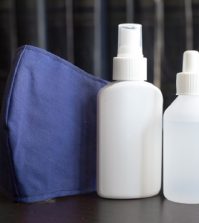- Study Says Most Parents Don’t Use Car Seats In Ride Share Vehicles Like Uber
- This 12-Year-Old Boy Is A Sophomore Aerospace Engineering Major!
- Fire Safety Experts Warn Of Hand Sanitizer Danger After A Mom and Kids Escape House Fire
- Recall Alert: Peaches May Be The Cause Of Salmonella Outbreak, 68 People Ill
- Summer Vacation In The Days Of COVID: Tips To Stay Safe
- How To Safely Grocery Shop During The Coronavirus Pandemic
- Michigan Teen With Vape-Related Illness Undergoes Double Lung Transplant
- Teen Kicks Off Anti-Vaping Campaign From Hospital Bed
- Teenager Receives Life Sentence For Strangling Sister To Death Over A Wi-Fi Password
- Toddler Falls To Death From 11th Deck of Cruise Ship
E-Cigarettes and My Kids: Should You Worry?


E-cigarettes have been in the news a lot lately, and with more and more questions surrounding their safety moms and dads all over are beginning to question how to handle these devices and the potential dangers they may carry. From concerns surrounding e-liquid poisoning to worries about secondhand exposure to electronic cigarette vapor, could it be that e-cigarettes seem to be adding even more concern for parents than their combustible predecessors?
What are e-Cigarettes?
First introduced on the market back in 2007, the e-cigarette is a smokeless alternative to burning tobacco. E-cigarettes unlike regular cigarettes heat up what is known as an e-liquid, that may or may not contain nicotine, in order to create an aerosol to inhale. Since the carcinogens that exist in tobacco come out when they are burned at high temperatures, the e-cigarette creates a safer alternative for those wanting to replace cigarette smoke with something that appears to be less harmful.
E-Cigarette Vapor
According to American’s for Non-Smokers Rights, secondhand smoke kills more than 50,000 people yearly making the dangers of secondhand exposure all too real. Secondhand smoke affects children, elderly, pets, even the healthiest among us is at risk, but our children are one of the most vulnerable populations.
While there is still a lot of debate on how safe e-cigarette vapor, very few people question the fact that e-cigarette vapor is far safer for you than regular cigarette smoke. Naturally, there is a strong body of evidence confirming that second hand vapor is indeed safer, containing measures less harmful toxins than regular cigarette smoke. In fact, many experts believe e-cigarette vapor contains similar levels of potentially harmful constituents as the ambient air around you that you breathe.
Adding to the body of evidence, an even more recent study suggests that as an aerosol, the vapor will dissipate in a matter of seconds, making secondhand exposure nearly impossible.
What Should Parents Do?
While there is a lot of evidence of the relative safety of e-cigarette vapor, you won’t find many parents that will still open the door to vaping around their child. And really, there is nothing wrong with that. Evidence aside, vapor has no place around children, and it’s not the end of the world to assert your authority if you feel uncomfortable with an active vaper in the presence of your kids.
When asking an e-cigarette user to refrain from vaping, consider inserting a little praise. Telling a vaper you are grateful there is one less smoker in the world, makes it a lot easier should you feel the need to address concerns with vaping exposure.
E-Liquid Poisoning
One of the scariest aspects of the recent increase in e-cigarette popularity has been the rise in e-liquid poisoning cases. E-liquids come in small bottles and often contain flavoring that some people fear can sound or look appetizing to a child.
In the last few years, nicotine poisoning cases have gone up from only 271 calls to poisoning centers in 2011, to nearly 4,000 calls a year in 2015. While this includes all nicotine calls, including chew and dry tobacco exposure, the rise can easily be attributed to the gain in popularity e-cigarettes have demonstrated in just a few years on the market.
It only takes a small amount of nicotine to constitute what could be a lethal dose, and most e-liquid contains enough nicotine to do just that. However, despite their coverage in the news, nicotine poisoning is quite rare. In comparison, while 4,000 sounds like a large number, in the same time period there were almost 300,000 calls to poison control centers regarding analgesics, like Tylenol, and almost 200,000 calls for cosmetics products. So while the numbers are increasing, in the larger scope of poison concerns for our children, they still fall pretty far down on the list.
Even if the bottles look appealing, many experts believe the reason we have a primarily lower grade, exposure calls is because nicotine exposure can result in illness at such low levels, that it most often prevents the user from ingesting more. In fact, Public Health England, a leading researcher in e-cigarettes in the global medical industry believes that “Serious nicotine poisoning seems normally prevented by the fact that relatively low doses of nicotine cause nausea and vomiting, which stops users from
“Serious nicotine poisoning seems normally prevented by the fact that relatively low doses of nicotine cause nausea and vomiting, which stops users from further intake.”
What Should Parents Do?
The best defense is education, the numbers show that when the media releases a story on e-liquid poisoning, the prevalence of call to poison control centers goes down. That is why education and sharing this information is key to keeping our kids safe.
If there is anyone who has e-liquid in your home, encourage storing in safe, high or hard to reach places. It only takes a split second for a young one to grab a hold of one of these, so instruct houseguest who may vape to keep their supplies well-guarded if need be.
Warning Signs of Nicotine Poisoning Include:
- Vomiting
- Dizziness
- Lethargy
- Nausea
- Abdominal Cramps
- Agitation
If you feel your child is at risk for nicotine poisoning, seek medical help immediately. You can also call your local poison control center or the American Association of Poison Control Centers at 1-800-222-1222.








0 comments